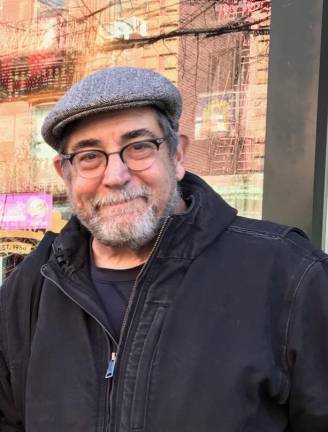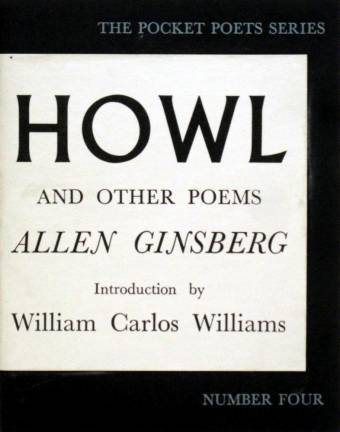The Resounding Wail
A look back at Allen Ginsberg’s “Howl” on its 65th anniversary


From its electric start to its galvanizing end, Allen Ginsberg’s “Howl” is ever vital as it celebrates its sixty-fifth anniversary this year. Epic in scope yet intensely personal in effect, the four-part poem was written in a modest cottage in Berkeley, California in the mid-1950s but it has echoed across the world in the decades since.
Its sky-cracking scream resounds especially now as New York and the entire world faces the coronavirus, its near infernal vision mirroring the tragedy that has shaken the globe. Ultimately, however, “Howl” liberates and seems made for dire times like these.
The late Ginsberg wrote the poem when he was on the cusp of his thirtieth birthday, and the work does have a young man’s ferocity. Opening with the now iconic line, “I saw the best minds of my generation destroyed by madness...,” the poem goes on to almost manically list the desperate actions of urbanites, whether it be those “looking for an angry fix” or ones who “ate fire in paint hotels” and “chained themselves to subways for the endless ride from Battery to holy Bronx.”
Whereas previously there was the more contained poetry of Rainer Maria-Rilke or Robert Frost, here was a work that let loose, its long lines sounding like winding saxophones, its burning fever literally taking away the reader’s breath. First recited in full at the Six Gallery in San Francisco in 1955 with Ginsberg unabashedly describing drug addiction and homosexuality, the poem ignited an obscenity trial but was published a year later by fellow poet, Lawrence Ferlinghetti, through his new City Lights bookstore and publishing house.
Speaking by phone from City Lights, which still stands in San Francisco after nearly seventy years of business, its CEO and Publisher, Elaine Katzenberger, reflects that Ferlinghetti “was clearly very excited” by Ginsberg’s incendiary offering, going on to say, however, that, “I don’t think he ever, in a million years, was thinking that ‘Howl’ would be this snowball” that would do no less than rock the world.
“A True Tzadik”
Not only did the poem help start the Beat movement, which includes such acclaimed works as Jack Kerouac’s novel, On the Road (1957) and William S. Burroughs’ Naked Lunch (1959), “Howl” presaged the punk of the 1970s as embodied by The Clash, the hip-hop of the 1980s as personified by Public Enemy, and the art rock of the early 2000s as boomed by TV On the Radio. “We’re howling forever,” Tunde Adebimpe sings on that Brooklyn-rooted band’s “Wolf Like Me.” Ginsberg has, in fact, been called the first hipster yet his benevolence transcended even culture.
“He was a true tzadik,” Bob Rosenthal, Ginsberg’s secretary and friend of twenty years, recalls, using the Hebrew term for righteous man. “He had a laser-like vision; he could look into your inner being and talk to, what he would call, your little bodhisattva,” Rosenthal says over a bowl of cabbage soup at Veselka in the East Village, just a few blocks away from where Ginsberg lived.
“He loved this neighborhood, the freedom of it,” continues Rosenthal, a poet himself who authored the celebrated “Cleaning Up New York” (1976) and, more recently, “Straight Around Allen: On the Business of Being Allen Ginsberg” (2019), his non-fiction account of his time with the poet. Such freedom is inherent in Ginsberg’s bombshell poem.
“’Howl’ is always called angry but, really, it uses anger,” Rosenthal explains. “It is a prophetic text, a liberating document. It liberates you,” he continues, likening the poem to a lost book of the Bible. Along with “Kaddish,” “Howl” is, in fact, one of Ginsberg’s most revered poems and it has often been compared to T.S. Eliot’s “The Waste Land” (1922).
Like that poem, “Howl” is somewhat apocalyptic, especially in its second part with mentions of “Moloch! Solitude! Filth! Ugliness!” and “Children screaming under the stairways! Boys sobbing in armies! Old men weeping in the parks!” It has imagery that is particularly vivid and searing today, its “a thousand blind windows” peering into the stunted lives of modern New Yorkers who are trying to survive the pandemic just as its “robot apartments” speak to the monotony of everyday life.
The poem is redemptive, though. “I’m with you,” goes the refrain of part three and, reading those words, one does feel immensely comforted by Ginsberg. All who came before, such as the ones “with dreams, with drugs, with waking nightmares” and the individuals who were “yacketayakking screaming vomiting whispering facts and memories and anecdotes and eyeball kicks and shocks of hospitals and jails and wars” are now truly seen, a messiah eyeing them and nodding acceptance even as they remain tortured and flawed.
Ultimately, the poem is a rallying cry, a bellow from deep within; beginning with fifteen uses of the word “holy,” the Footnote to “Howl” then says, “Everything is holy! everybody’s holy! everywhere is holy! everyday is in eternity! Everyman’s an angel!” Over six decades after its publication, “Howl” leaps off the page and pushes one to go on in the dregs of the plague, to awaken on an ashen city and wail to the moon.